| |  |
|
REMEMBERING THE ROLLING STORES
© Copyrighted 2014 - Herman McDaniel - All Rights Reserved
"The rolling store's coming!" The first person to see the approaching store-on-wheels typically yelled to alert family and neighbors to get to the road if they wanted to conduct business with the store-on-wheels that day.
Because so many rural families came to depend upon these unusual dry goods stores, several companies had rolling stores serving routes in Murray County in the 1930s and 1940s.
JOHN WESLEY EVANS INTRODUCES HIS ROLLING STORES
The first rolling stores serving Murray County were operated by a company in a small Gordon County town called Ranger, south of Chatsworth on Highway 411.
In the late 1920s, a Ranger businessman, John Wesley Evans, saw a disturbing decrease in sales at the Ranger store he co-owned with his father. Evans knew that times were tough and money was scarce. Families raised most of what they ate and made much of what they wore. Lacking money with which to buy things, many farm families only went to town two or three times a year.
Since his traditional store business was off, Evans came up with the idea of building a store-on-wheels and taking his best selling, basic items on the road to various communities in nearby counties. He reasoned that this approach would enable people to buy his goods without ever visiting the actual store in Ranger.
Evans created a large wooden box style building on a truck chassis, and equipped its interior with appropriate shelving as well as a counter, and storage space to operate a small dry goods store on wheels. This unusual store was better stocked than most of the rural, family run stores that then dotted Murray County–many were only open limited days/hours or when someone rang a loud bell near the store's entrance to summon a family member to stop whatever he or she doing and come open the store for a customer.
It quickly became apparent that Evans' bright red, store-on-wheels had become very popular with the mainly country folks he served. He said that he chose red because customers could see the store approaching from a great distance and they knew that something that big and so red had to be his rolling store.
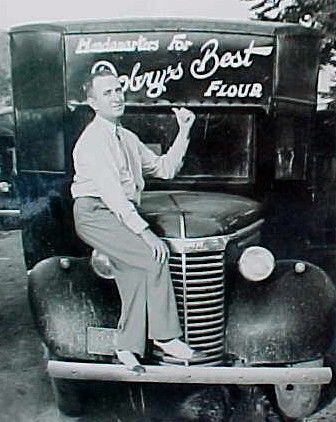
John Wesley Evans
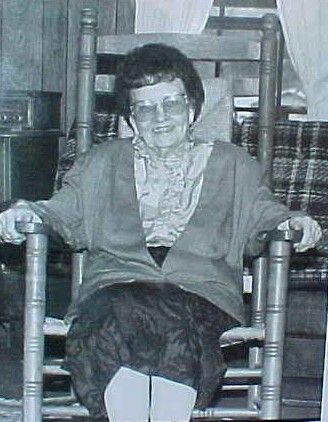
Mrs. John Wesley Evans
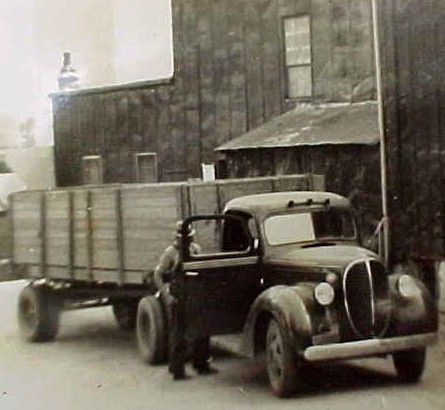
Evans Trailer Hauled Fruit from Florida.
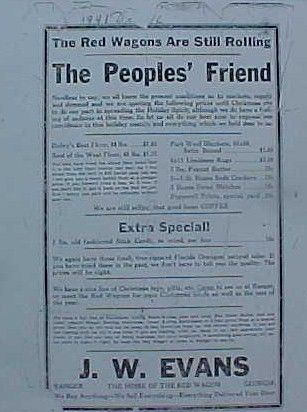
Evans Flyer Dec. 1941.
Evans eventually owned 7 rolling stores that he sent to communities in Gordon, Murray, Pickens, and Bartow counties every week. On his traditional store building in Ranger he erected a sign proclaiming it to be "The Home of the Red Wagon."
A newspaper article, published in the Heritage Edition of the Calhoun Times, in 1987, about John Wesley Evans' rolling stores, plus a listing of his December 1941 Rolling Store prices can be found following this article. Paul Burgess, son-in-law of John Wesley Evans, also provided names of several men he said had worked for Evans during the rolling store days–that list also is at the end of this article. Any one remembering additional employees of that era should submit their names to be added to this museum section. Any photos of any of these people or of rolling store customers will also be welcomed.
HAMRICK DECIDES TO COMPETE
Other merchants quickly saw that taking the store to various communities was a successful business idea and several decided to do the same. It wasn't long before Evans had competition from the H. F. Hamrick Store, located across the highway from Evans' Store in Ranger. Mr. H. F. Hamrick built his rolling stores roughly the same size and shape as the Evans' stores. He painted the H. F. Hamrick rolling stores dark green. Both Ranger companies soon had rolling stores serving several counties; both sent stores into various parts of Murray.
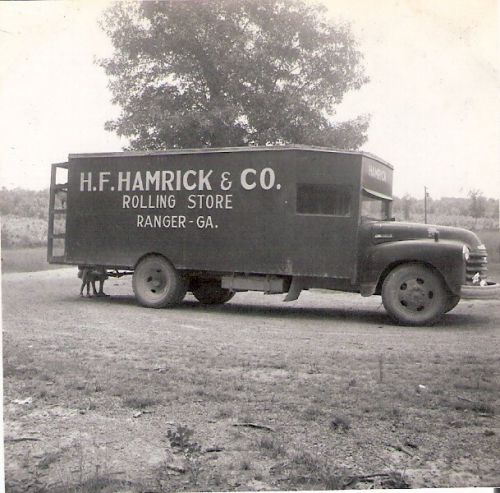
One of H. F. Hamrick's Rolling Stores.
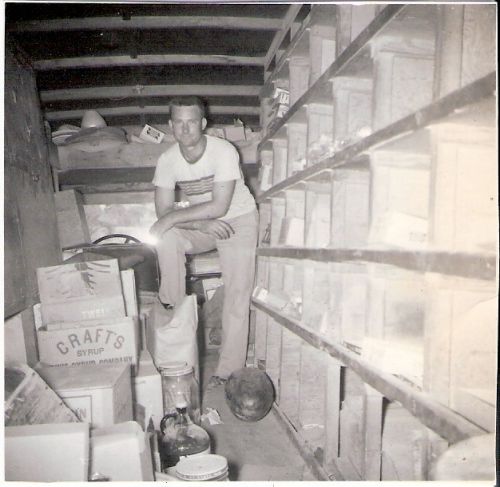
Hamrick's Rolling Store.
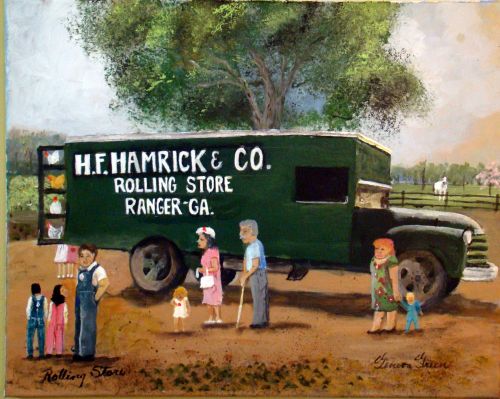
Painting by Geneva Green for Murray County Museum.
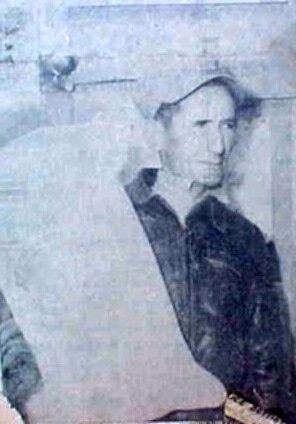
Customer with Bag of Flour.
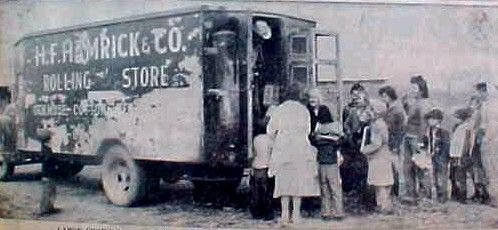
Customers had to wait their turn to actually enter the rolling stores.
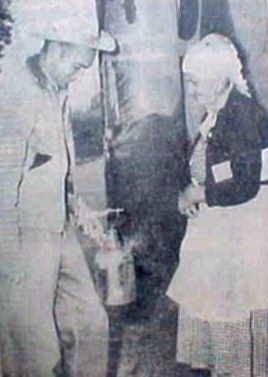
Customers bought kerosene from the rolling stores to burn in lamps to light their homes.
In 1942 one of the most disastrous fires in Gordon County's history, destroyed three rolling stores and two warehouses belonging to H. F. Hamrick. The Calhoun Times & Gordon County News, September 23, 1992, published an article recalling this fire from 50 years earlier. That news story appears after this article.
One of the H. F. Hamrick drivers that many Murray County folks remember was Jay Freeman, brother of Carl Frank Freeman, Sr., who lived beside the post office in Spring Place. Jay lived in Ranger.
If any museum visitor knows with certainty the names of others who worked for H. F. Hamrick, or has photographs of H. F. Hamrick's rolling store customers in Murray County, please submit items to be added to this museum section.
ROLLING STORES BY QUARLES AND WESTFIELD
Seeing the popularity and success of the Ranger-based rolling stores operating in Murray County, Quarles and Westfield of Chatsworth built and provisioned two rolling stores that also traversed Murray County. Jeff Wilbanks drove one of these and Claude Ballew drove the other.
If any one remembers further details about this operation, or has additional pictures of employees or customers, please send details to the museum to be added. Further, if anyone knows for certain what color the Quarles and Westfield rolling stores were, please contact the museum; none of the people interviewed for this article remembered what color the Quarles and Westfield rolling stores has been painted.
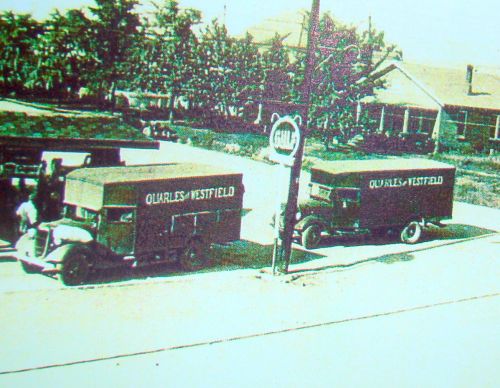
Quarles and Westfield Rolling Stores.
William Leonard, who worked for Quarles and Westfield during their rolling store days, remembers that these rolling stores operated in the 1930s, 40s, and possibly into the 1950s. He said that both of the company's stores-on-wheels served regular routes across Murray County either 5 or 6 days each week.
Leonard said that Quarles and Westfield had people who worked later than the store's traditional open hours, so they could handle whatever items the drivers had taken in each day, clean the stores, and restock them, making them ready to roll the following day.
Robert Green Remembers the Quarles and Westfield "Rolling Store" That Served Crandall.
"I have many memories growing up in Crandall, Georgia, Murray County. In 1938 my mother Ethel Quarles Hampton, my stepfather J.P. Hampton, and I lived on the Old Federal Road in Crandall, Georgia."
"The first house we lived in belonged to Jim Poteet and was across the road from George W & Rosa Hampton, J P's parents and was located just south of the Arthur Wilson Grocery Store. After a couple years we moved down the road a short distance to a house & farm owned by Harley Plemons where we lived until the fall of 1945, about the time WWII ended. We had only about $200 a year for food & household items. Most all of our food came from the garden, chickens and hogs killed in early winter. Our only means of transportation during the late 1930s-early 1940s were our two mules and wagon. The Rolling Store was an important means to obtain basic items for survival during this time."
"Once a week on a certain day and approximate time the Quarles & Westfield's Rolling Store came rolling up the Old Federal Road along the foot of the mountains between Chatsworth and Eton and on up past the Hickey, Phillips and Loughridge homes and into the small community of Crandall. The road was unpaved at that time and our house was very close to the road. The Rolling Store would pull up and park on the side of the road in front of our house. There were only two other homes nearby and I do not remember any other customers meeting the rolling store there where we lived. Being a very young boy my main concern was getting some candy or chewing gum."
"Unlike Crandall's Grocery Store, the Rolling Store would accept chickens, eggs, shelled corn, and a few other items in trade for things we needed. As I remember my mother or step-father would buy or trade for flour, corn meal, salt, sugar, soap, washing powders, and kerosene. I do not remember my mother or step-father buying shoes, clothes or cloth from the Rolling Store. They could have but my interest was something sweet to eat. Even today I can remember the wonderful aroma inside that Rolling Store."
"Being very young at the time the one thing I distinctly remember is being able to trade rabbits I had caught in my rabbit traps (boxes) for candy and chewing gum a couple times. This was usually the only way I got anything sweet. Any money available to me was spent on school supplies and clothes. The Rolling Store man would only accept the rabbits killed and "gutted", during the cold winter months. They were hung on the outside of the Rolling Store. I do not know what he did with the rabbits but suppose someone wanted them for the rabbit fur or to make rabbit stew. Or, he may just have felt sorry for a small 7-9 old boy with that hungry look in his eyes."
"The Rolling Store was a truck engine and chassis with a large wooden and tin box built on the back of it. I think it was painted red or perhaps green. I can also remember a wire cage built on the outside rear of the Rolling Store to keep live chickens. As I remember the chickens were worth about 50 to 75 cents apiece depending upon their weight. A scale was used to weigh items bought or sold. Kerosene was sold by the gallon drained from a tank also mounted on the outside rear of the Rolling Store. The kerosene was used to start fires in the fireplace or kitchen cook stove which burned wood. We did not have electricity in the house until about 1944 as I remember."
Tim Howard's book, Murray County Heritage, published in 1987, contains this passage, on page 46, paragraph 3: "In the 1930s, long time resident Claude Ballew operated a "rolling store." The store on wheels provided many goods for those who were unable to go to Chatsworth." Claude Ballew was identified elsewhere as a driver for Quarles & Westfield. It is unclear whether he might have also actually started a rolling store company.
MONT ROBERTS RAN A ROLLING STORE
William Leonard also remembers that a man named Mont Roberts operated a store where Benny Huggins' Tax Office now is located on 3rd Avenue, Chatsworth. Leonard said that Roberts also ran a rolling store but he does not recall when this company started their rolling store operation nor how long it lasted. He remembers that Robert's son drove the rolling store. Very little information has been found regarding this operation. If any museum visitor knows more about this particular rolling store operations, please contact the museum to share what you have or know.
HOW ROLLING STORES DIFFERED FROM TRADITIONAL STORES
Of course all of the companies would have had to have similar operations. Someone would do bookkeeping and accounting details when each rolling store finished the day. Someone had to handle special orders to make certain that items that had been promised to be delivered the following week would be available in the correct size, color, style, etc., promised by the driver. By today's sizing standards some of the specifications for special orders seem very strange. For example, someone ordering shoes might give the driver a pencil drawing/tracing of the outline of a person's foot because they did not know what size to ask for. It also was common to just bring in a piece of wood or a small tree limb that was the same length as the person's foot.
All of the rolling stores that accepted payment for goods in the form of butter, eggs, live fowl, freshly killed (dressed) rabbits, squirrels, etc., had someone at the home store who accounted for these transactions and disposed of the bartered goods in a manner that was as profitable as possible for the company. For example, Paul Burgess, son-in-law of J. W. Evans, said that Evans' rolling stores took in so many squirrels and rabbits that they had a contract to deliver them to a buyer in the Atlanta area by pick-up truck. He said that they had various buyers for the butter, eggs, chickens, ducks, turkeys, etc., accepted as payment for merchandise each day. Burgess remembers that the Evans slogan was "We Buy Anything. We Sell Everything."
The Amie McDaniel family lived on highway 52/76, the Chatsworth to Dalton Highway, about a mile and a half west of Spring Place. Carlton and Herman clearly remember the late 1940s and early 1950s, when the rolling store served families living on or near this highway. Nearly all of the houses fronting on the paved highway had electricity, but some on unpaved roads just off of the highway did not. They still relied on "coal oil" burning lamps to light their homes at night. They regularly met the rolling store, carrying cans or jugs, to buy a week's supply of kerosene.
Everyone living along the Chatsworth to Dalton highway knew approximately when H. F. Hamrick's huge, dark green truck would appear. One of the children usually would be appointed to watch for the arrival of the rolling store and yell to everyone nearby when they first saw it approaching. Those wanting to buy something would wave for the driver to stop. He pulled the vehicle to the right shoulder of the highway, parked, then walked to the rear and opened the door to the store. Customers then climbed the steps to enter the store on wheels. If more than 5 or 6 people wanted to enter, they had to wait their turn as the store space was very cramped and could not accommodate many people.
A kerosene tank holding perhaps a hundred gallons was mounted beside the steps on the back of the truck. A series of wire cages for hauling live fowl had been mounted on the opposite side. Customers could buy the live chickens, ducks, guineas, etc., or trade in some of their own to pay for whatever they wanted from the store.
For farmer families of that era, this was sort of like "going to town" because they were able to buy basic needs without making the trip. Better yet, they could barter for their merchandise from the rolling store, whereas most retail stores required payment in cash–"real money" was a term often used by old-timers. The rolling store accepted live fowl–chickens, ducks, guineas, and turkeys, as well as eggs, butter, even dressed rabbits, in barter for anything they sold.
The inside of the store had lots of shelves and drawers, as well as a counter top used for cutting fabric from a roll, slicing baloney and cheese, and stacking items being bought until they could be "toted." The driver wrote the price of each item in a column on a brown, paper bag (then called a "poke"), then he totaled the customer's purchases and accepted payment. Finally he placed the items in the bag he had used to compute the total owed and handed the bag to the customer, as he said thank you.
Because space was so limited, the store only carried as much of each can or box of goods as the owners thought might be sold in a single day. Each night the rolling store returned to its home base where it was restocked in preparation for the next day's trip. Companies employed people to work night shifts to do all that was necessary to have the rolling store cleaned and restocked, ready for the next day's run.
Of course, the rolling store sold basic school supplies, tablets, pencils, crayons, composition books, notebook paper, ink, glue, and fountain pens.
Basic sewing needs were also available–scissors, needles, thimbles, thread, buttons, rick-rack trim, clips, hooks, dress patterns, and even a few bolts of cloth from which customers could buy as many yards as needed to make a dress.
They also sold chewing tobacco, snuff in glasses that were later used as drinking glasses, Prince Albert tobacco in cans, cigarette papers for rolling your own, even smoking pipes. To light cigarettes and pipes, as well as to light fires in heaters, fireplaces, and cookstoves, families bought boxes of wood matches that could be ignited by rubbing the end across any hard surface or by clicking it with a thumbnail.
Wash day goods were some of the best sellers–especially Clorox, and Octagon soap. Bluing, borax, and starch also were available. Many families still used home-made lye soap to wash clothes and scrub floors.
All of the rolling stores sold shaving mugs and brushes, razor blades, combs, tooth brushes, tooth powder, women's lotion, shaving lotion, and hair tonic.
Medical items included aspirin, Ex-Lax, cough syrup and drops, Watkins and Rosebud salves, iodine, medical tape, and gauze.
Farm families of that time bought flour in 50 pound cloth sacks. The sacks were cotton fabric in attractive patterns that women used to make dresses. Since farm families were large, and baked biscuits were served every morning with breakfast, it didn't take long to collect several flour sacks of the same pattern. They also bought lard, sugar, salt, corn meal, coffee, tea, cocoa, baking powder for biscuits and baking soda for corn bread.
Most people remember well the three sandwich staples available from most rolling stores–bologna, cheese, and bananas cut from a hanging stalk. They also bought mayonnaise or miracle whip, mustard, and peanut butter, as well as wax paper to wrap the sandwiches youngsters would take to school for lunch. Schools did not have lunchrooms until World War II ended and military barracks were declared surplus and made available to schools to use as lunchrooms. Classrooms and cloak-rooms usually smelled of banana sandwiches.
Kids lucky enough to have a nickel were more interested in which of the 5 cent items they might buy. Would it be a Moonpie, a pack of peanuts or potato chips, a pack of crackers with peanut butter, a fried apple pie, or a Hershey bar, Payday, or Butterfinger? Each sold for a nickel but nickels were scarce and buying any of these was a rare occurrence for most youngsters. Soft drink options included Coca Cola, NuGrape, and others of similar size selling for a nickel, but the larger bottles of Pepsi and R.C. Cola sold for 6 cents.
At Christmas time the rolling store sold boxes of chocolate covered cherries, family-size boxes of hard, stick candies ( peppermint stripes was the best seller), orange colored, marshmallow peanuts, and gallon glass jars filled with chocolate drops. They also had pecans, English walnuts, and Brazil nuts, called at that time by everyone who bought them, "nigger-toes." Most rolling stores also sold during December oranges, tangerines, and coconuts. To take advantage of customers' interest in buying citrus fruit during the holiday season, John Wesley Evans built a huge trailer that they took to Florida to negotiate a favorable price for buying such a huge quantity of citrus fruit, and to ensure that they had sufficient supply of these items to last the holiday season.
The men who worked on the rolling store seemed to like youngsters. Most of the folks interviewed recall they always said "thank you" to the adults and then to the kids they would say "Bye, buddy," or "Bye, Sweetheart," making each child feel a bit special. The people interviewed also agreed that, at that time, rolling stores were a very welcome and pleasant part of their lives.
*******************
Mr. Evans' Rolling Store
Terry Townsend
Heritage Edition
Calhoun Times, 2-25-87
"I'm not plowing another day; I'll make a living some other way," John Wesley Evans said at age 16.
John Wesley Evans, namesake of John Wesley, the founder of the Methodist belief, was born in Gilmer County, January 31, 1901, and died July 14, 1972.
As a little boy he often traveled in covered wagons with his father, who was a merchant. He traveled through Cartersville, Rome and surrounding areas with market wagons selling various items to the people living there. He and his father slept under the wagon at night or in a neighbor's barn.
He attended school at Powder Springs, hitchhiking back and forth on weekends.
After his decision to do something more in life than plowing, he began looking for a job. His first job was as a hat salesman. Although successful, he decided to change jobs because there were few, if any, promotions in selling hats.
Evans' next job was selling Model T Fords in Fairmount. His employer called him "the best salesman I ever had." But Evans was not content to spend his life at this.
So Evans and his father then went into the dry goods store business together. Later Evans set up his own in Ranger, and then married. A month after the marriage, his store burned, destroying much of his merchandise. He began again, buying merchandise on credit and operating out of a rented building.
Business was good in the 1920s, but as the effects of the depression were realized, business dropped off. Evans decided to take his store to the people.
His solution was to have a "rolling store" built. This was a large truck filled with necessities for the average family such as food, clothing, shoes, matches, and many other articles.
A rolling store became a "must" to everyone during this time. In this part of the country many people still depended on wagons for transportation in the 1930s. A family was lucky if they were able to come to the main store three or four times a year.
Evans eventually had seven rolling stores built to cover Pickens, Bartow, Gordon, and Murray counties every week. Each store had a different route each day.
The slogan of the rolling stores was "We Buy Anything. We Sell Everything," meaning he would trade anything the customer had for what the customer needed, for hard cash was very scarce.
The rolling stores were painted red and all the drivers wore red shirts. The main store in Ranger was called the "Home of the Red Wagon."
The "Home of the Red Wagon" employed seven drivers, two nightmen, two bookkeepers and one Sunday man. The drivers' workday started at 7 a.m. and usually ended about 10 p.m. The two nightmen reloaded the rolling stores for the next day. The two bookkeepers kept the books on everything sold or traded. The bookkeepers also kept up with the customers who bought on credit. Many people bought on credit throughout the year and then paid their bills in the fall when their crops came in. The Sunday man watched the store on Sunday.
Food prices, compared to today, were extremely low. For example, one pound of flour was 2¢, baking soda was 5¢, a box of four pounds of lard was 45¢, hominy was 5¢ per pound, coffee was 15¢ per pound, and ham was 25¢ per pound.
It was not unusual for a family to purchase 1000 to 2000 pounds of flour or 100 pounds of dried beans at one time.
In the fall, the father or mother would come to the main store with shoe sticks of the size of each child's foot. Purchasing shoes was not the problem it is today because shoes were not picked for beauty but for how long they would last.
The rolling stores continued to operate during the World War II years when gas was rationed and farmers were shorthanded.
After the war ended, people began going to town more often and soon rolling stores were not needed at all. Thus ended a unique era in Georgia Mountain history.
 The Peoples' Friend
The Peoples' Friend
The Red Wagons Are Still Rolling
Needless to say, we all know the present conditions as to markets, supply and demand and we are quoting the following prices until Christmas eve to do our part in spreading the Holiday Spirit, although we do have a feeling of sadness at this time. So let us all do our best now to express our confidence in this holiday custom and everything which we hold dear to us.
Dobry Best Flour, 48 pounds $1.85
Best of the West Flour, 48 pounds $1.75
You who have tried this flour know that it is the best flour money can buy.
Part Wool Blankets, 66 x 80, Satin Bound $1.69
9 x 12 Linoleum Rugs $3.59
2 lbs. Peanut Butter 25¢
2 1lb Boxes Soda Crackers 15¢
3 Boxes Swan Matches 10¢
Pepperell Prints, yard 20¢
Extra Special!
2 lbs old fashioned Stick Candy, assorted, per box 16¢
We again have those fresh, tree-ripened Florida Oranges, natural color. If you have tried them in the past, we don't have to tell you the quality. The prices will be right.
We have a nice line of Christmas toys, gifts, etc. Come to see us at Ranger, or meet the Red Wagons for your Christmas needs as well as the rest of the year.
J. W. EVANS
The Home of the Red Wagon
Ranger, Georgia
We Buy Anything–We Sell Everything–Everything Delivered to Your door
*******************
EVANS' EMPLOYEES DURING
ROLLING STORE DAYS
Provided by Paul Burgess
Jay Coggins - driver
Charlie Goble - driver
Pat Goble - driver
Lloyd Puckett - driver
Causby Shirley - driver
Bercie Shirley - driver
William Ingle - worked in store
Glen Yancey - worked in store
Otis Burton - bookkeeper and notary public
*******************
Hamrick Rolling Stores
Looking Back 50 Years
transcribed from Calhoun Times & Gordon County News,
issue of September 23, 1992
Fifty years ago, in one of the most disastrous fires in the history of Gordon County, the mammoth store of H. F. Hamrick at Ranger was completely destroyed, according to the September 14, 1942, issue of the Calhoun Times.
The store was one of the county's oldest and best known institutions.
In addition to the store building, three "rolling store" trucks and two warehouses containing large stocks of flour and feedstuff were also totally destroyed.
Estimates place the loss at between $25,000 and $40,000.
The entire town of Ranger narrowly escaped destruction, and observers say only the fact that there was no wind blowing prevented a complete burnout.
Hamrick's home was saved by the heroic efforts of volunteer firefighters, who came from miles around to help combat the blaze.
Also, the store building of J. W. Evans, just across the highway, was in imminent dangers, its walls getting so hot that water thrown on them would "fry."
The fire apparently started in the northeast corner of the building where the three rolling store trucks were housed, each loaded with merchandise ready for another trip.
Hamrick was able to save approximately $2,000 worth of merchandise from the blaze and moved the remnants of his stock into a building that he owned across the highway.
----------------------
Rolling Store Remembrances
Annice Bowers Elrod:
"I'll never forget Hamrick's Rolling Store stopping at my grandmother's house (Tennie Caylor Baxter) where I spent most of my time until high school age. The driver was a big man and his name was Red. My grandpa's (Tom Baxter) faithful and protective dog of many years had passed away. Red knew how much Jerry had meant to the family. I was probably about seven or eight years old at the time."
"A few weeks later Red got out of that big green truck and I was waiting with much more enthusiasm than on his normal Wednesday rounds on Halls Chapel Road in North Murray. I knew I was getting a special delivery that day and it wasn't even going to cost anything. I can still feel the excitement as Red handed me the most adorable collie puppy. I named her Nancy. I'm not sure why I picked that name."
"Nancy was my constant companion and filled many lonely hours after my Pa Tom passed away the summer between my seventh and eighth grade school years. Red was more than just a rolling store operator....He was a friend to all his customers and my grandmother always had him a piece of pie or cake waiting."
Carolyn Zelinsky Luffman:
"When my granddaddy, Rev. C. W. Hayes, went on a revival trip in the summer, we would get our groceries from the rolling store which came on Thursdays. I was fascinated with all the little "boxes" on the walls that held the can goods. When we bought candy the driver put it in little sacks."
"I remember that I liked the smell of the hog and chicken feed in the big cloth sacks. My grandmother made quilts from these sacks. If she got enough of them with the same pattern, she would make clothes from the sacks."
"Our rolling store came from Ramhurst but I don't know it's route. What was more important to me is that it stopped at Nannie Hayes' and Clint Bryant's."
Jerry Luffman, Carolyn's husband, recalls:
"The rolling store truck was big and green. It stopped at Momma and Poppa Thornton's. (Hattie and T. P. Thornton who lived near Free Hope Church.) It had wire coops for chickens and rabbits on the back of the truck. Jimmy and Johnny (Luffman) would catch rabbits and trade them for chickens. The candy often was dusty."
LeAlice Thornton Mann confesses
"Mother and Grandmother would sometimes share their egg-and-chicken money with us children giving each of us a couple or three pennies. We bought candy with those pennies. Our Dad did not approve of us eating candy, saying that it was not good for our teeth. But Mother and Grandmother let us buy the candy from the rolling store and advised us to eat it in a hurry so Daddy would not know."
"Since we so seldom got to visit any store, being able to look into the rolling store was sort of like magic to use kids."
Bobby Mosteller, who lived at Ramhurst, remembers:
"My mother always waited for the rolling store. We traded eggs, chickens, rabbits and maybe butter; if she had credit left after getting her necessities, she would buy Nigger-toes, the little candy pyramids, and chocolate covered coconut candy. We would go into the house and sit around the table eating the candy with soda crackers; today that seems so unusual."
| | |  | |



